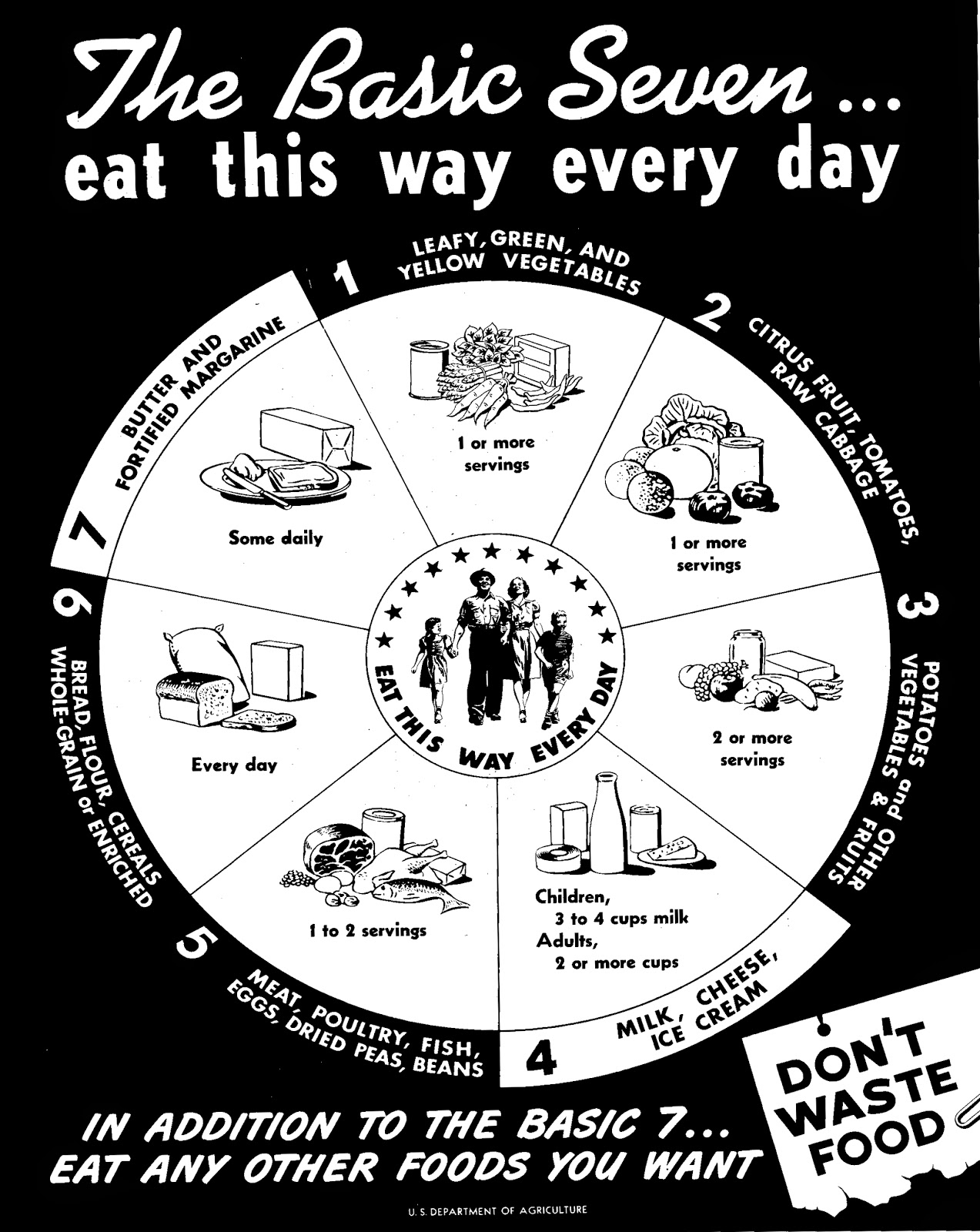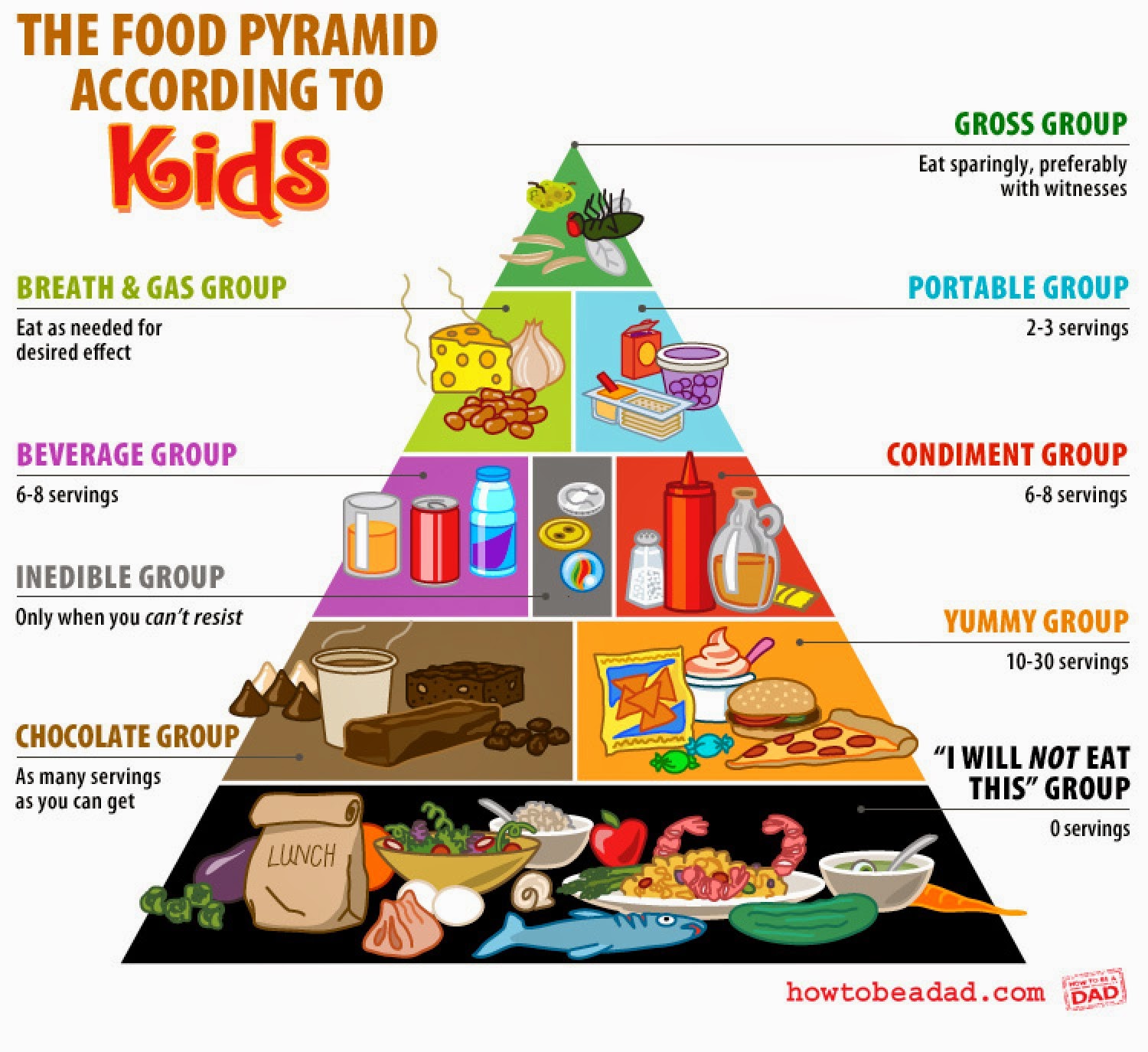My kind of food pyramid!
How many of you remember being told how to eat with some goofy chart on the wall at school when you were growing up? In the last 100 years, the USDA has redefined our food into segregated groups including the Basic Seven, the Four Food Groups the Six Categories of Food, plates, pyramids and wheels. It's no wonder that with all of these changes along with fad diets and the evil food of the year (red meat, butter, eggs, cheese, potatoes and refined grains to name a few) that we are a nation of confused consumers who turn to fast food because we just don't know what to fix for dinner. Our meals have become portable for your convenience and to the detriment of your health. We put everything into cups and tubes and snack bars that we can keep in our desk drawers and purses and glove compartments so we never have to go without food for any length of time. Unfortunately, our nourishment is not so nourishing anymore.
Let's take a look at how the USDA has turned nutrition into an information nightmare over the last 100 years (don't worry, there won't be a pop-quiz at the end).
In 1916, the USDA brings us "How To Select Food", which focused on household measures, food groups and what they dubbed "protective" foods. It was based on healthy choices and serving sizes and got Americans considering what we were putting in our mouths and how much. Then in 1941 the USDA created the Recommended Daily Allowances for nutrients and laid out for us "The Basic Seven" food groups in "A Guide to Good Eating". The Basic Seven focused on the number of servings Americans should eat from some very confusing food groups. #1-milk and milk products, #2-meat, poultry, fish, eggs, beans, peas and nuts (very specific. Could've said "proteins", but thanks for laying it out, guys) #3-bread, flour and cereals, #4-potatoes and sweet potatoes (not a veggie, not a starch. Potatoes-they're their own thing!) #5-Leafy green and yellow veggies (wait for it!) #6-citrus, tomatoes, cabbage and salad greens (leafy greens and salad greens are two different things? Wow! No wonder Americans don't know how to eat!) and #7-butter and fortified margarine! So where are bananas and apples? Are there no berries in our diets? What happened to all the vegetables that aren't yellow or leafy-green? Could you eat asparagus, or was it not invented yet? I'm already lost! But it was a start, a basis for an idea of what to eat to be healthy. A for effort, fellas! You gotta start somewhere!
In addition, eat ANY OTHER FOODS YOU WANT? I LOVE this plan!!!!
In the 1950's to the 1970's, the USDA came up with "Food For Fitness". Now we shorten our food groups from "The Magnificent Seven" to the "Fab Four". Easy! Meat and Protein, Dairy, Fruits and Veggies, Bread and Grains. The goal for this plan was to help us Americans obtain adequate nutrients in our daily diet. It DID specify amounts from these food groups. It DID NOT mention any guidance on fats, sugars or calorie intake. (Chocolate Cake, anyone?)
Then in 1972, the birth of the first food pyramid occurs in Sweden. The Swedes were gripped by high food prices, so their government tasked their National Board of Health and Welfare with coming up with a way to help that situation. In response, they came up with an idea about "basic" and "supplemental" foods-foods essential to a person's well-being and foods that provided the vitamins and minerals the basic foods did not. Then along comes Anna Britt Agnsater who worked for a retail grocery co-op. She creates the Food Pyramid, which is criticized for not showing serving sizes or how much of each food type should be consumed. In January of 1977, the American USDA releases new guidelines recommending folks reduce their intake of fat, saturated fat and cholesterol and INCREASE their carbohydrate intake to 55-60% of their daily calories! WHOA! That's a lotta noodles! The USDA claims that making these changes will lead to better heart health, even though there are no scientific studies that prove these link together. Whoops! Upon release of these new guidelines-surprise!-the cattle, egg and dairy industries begin to suffer. The report was revised later that year, but the damage is done. Americans are scared to eat hamburgers, fried eggs and cheese.
Yeah-I really don't get it. WHAT should I eat?
So in 1979, we adopt the "Hassle-Free Daily Food Guide", which is based on the "Basic Four", but adds a fifth group to highlight the need for moderate intake of fats, sweets and even alcohol! I don't remember THAT poster in my 4th grade class next to the kitten in a tree that said "Hang In There!". What an awesome nutritional message for us kids-"Finish your dinner and then help yourself to some Jell-O parfaits and a Tequila Sunrise. Then get to that homework, Junior!" I really miss the 70's. Good times, my friend. Good times.
You'll notice PORK is not an option. I wonder how pig farmers felt about this one?
In 1984 we see the birth of the Food Wheel, which includes goals for both nutrient value and portion control. There are five food groups and three levels of daily calorie amounts. This was originally created for a Red Cross nutrition course. Then, in 1992, we finally steal the food pyramid concept from Sweden! There are six food categories which are divided up and labeled with serving sizes as well as recommended servings per day. It's a lot of information and can be tricky to remember exactly how much of what foods you need every day. Remember, this is before we all had cell phones with apps to help us keep track of what we've eaten and what we still need to get in before days end! A lot of folks (especially the ones on fad diets) kept food journals to ensure they got all of their nutrients. Our Food Pyramid recommended 6-11 servings of carbs (SO MUCH GRAIN!!!!), 3-5 servings of veggies, 2-4 servings of fruit, 2-3 servings of meats (1 egg, 2 Tbsp peanut butter, 3 ounces of meat-ONLY 3 OUNCES!), 2-3 servings of dairy and, my favorite, fats/sweets/oils used sparingly. That's not confusing. Sweets are in my fruit and baked-goodness-carbs. Fats are in my dairy and meat. Where do potatoes live? Are they a vegetable again? And to keep an accurate account, you've got to know your serving sizes.
Simple-pimple. But define "sparingly use sweets". I could get into trouble here.
In 2005, the USDA revised the pyramid with meaningless, colored, vertical stripes, no numbers to explain the servings and serving sizes and a random stick man running up the side to tell us all to turn off the TV and get some exercise. This chart made no sense, told us nothing and didn't inspire anyone to recreate the scene from Rocky where he runs up the steps of the Philadelphia Museum of Art.
What the hell is this hot-rainbow-hued mess? And tell that guy to get off my dinner!
So, in 2011, First Lady Michelle Obama got involved and created "My Plate" with USDA Secretary Tom Vilsack. This visual cue is not intended to provide a specific message. The plate is divided into four quadrants that are slightly uneven (an OCD nightmare) and are labelled "Fruits", "Grains", "Vegetables" and "Proteins". The Grain and Vegetable quarters are the larger sections on My Plate. There is also a circle depicting your glass of 'Dairy". No serving sizes, no recommended servings, no explanation of what constitutes a grain or a protein. It's so open to interpretation and makes no mention of what is healthy and what isn't. My "balanced" My Plate meal could be mac-n-cheese, chicken nuggets, french fries (potatoes are a veggie, right?) and fruit snacks with a glass full of ice cream.
I'm lost. Is this for EVERY meal and snack?
All this leads us to a nation that is confused about what's healthy, what we need to be eating and how many servings of each of who-knows-how-many food groups. Not to mention our out-of-control portion sizes. It's no wonder I got this chunky in the first place!
Just because it cracked me up!








No comments:
Post a Comment